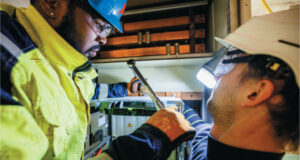What do you do when flooding overtakes your dryer section, yet you must meet production targets? What if you are faced with changing over a fine paper machine to produce fluff pulp
Recently, a Southern US kraft pulp mill’s maintenance team decided to bring in “expert eyes” to address immediate issues with evacuating condensate. The mill was also hoping the experts could propose efficient long-term solutions.

Typically, a detailed plan for dryer section optimization is developed and plotted out against a fast turnaround during scheduled shutdowns.
The team contacted Kadant Johnson. “We employed many specialized techniques to determine exactly why their dryer section was underperforming and initiated a precise plan for immediate intervention,” says Mark Franks, director of Kadant Johnson Services.
“We used dryer surface temperature measurements to pinpoint flooding on a can-by-can basis. In fact, 11 dryer cans were found to be flooded,” he says. “Further inspection revealed out-of-position syphons—with one installed upside down! We also observed syphon shoes with lock nuts made with nylon, which had melted.”
GENUINE PARTS MATTER
The problems didn’t end there. “We discovered an off-spec O-ring, supplied from a third party, being used to seal the horizontal syphon pipe,” Franks continues. “This off-spec part was the root cause of short-circuiting between the steam inlet and condensate outlet, further contributing to the flooded dryers. It pays to be wary of non-OEM or counterfeit wear parts. They are often sold as premium or ‘same-as’ quality, so it matters to consider the source.”
Franks stresses the importance of experience with steam flow dynamics related to dryer sections, as well as equipment itself. Many mills have outsourced service over the years to inexperienced contractors and the mill in-house experts are spread thin.
Taking advantage of a scheduled shutdown, the Kadant Johnson service team corrected faulty installations, replacing sub-standard components with genuine parts. They also installed a PTX steam joint and syphon system as part of a trial to demonstrate the effect of using a modern syphon system.

Working inside dryer cans requires advanced training and a commitment to safety—during the work and for the operators running the dryer section once the work is complete. “Being in and out of thousands of dryer cans, facing repetitive and unique problems, gives you an edge,” comments Kadant Johnson’s Mark Franks.
After the Kadant Johnson service team brought all 11 flooded dryers back online, Franks adds, “The mill maintenance team now looks to us to inspect, repair, and continuously find ways to optimize the dryer section. Dryer surface cleaning and NDT services are part of a new routine. Maintenance teams are freed up for other important productivity and safety projects.”
EASIER MACHINE CONVERSION
Ken Lahrke, director of technical services with Kadant Johnson, notes that converting a Southern US fine paper machine into a pulp machine, for example, often creates enormous challenges for drying.
“The challenges for this mill to convert from fine papermaking to specialty pulp grades in a relatively short period of time were enormous,” Lahrke explains. “Adding 40 dryer cans and then getting all 90 up and running at peak performance for specialty pulp grades required focus and a lot of determination. Our job to optimize ‘the old’ revealed a range of steam and condensate issues needing immediate attention. One issue was deteriorating bars, which had to go. Various issues with steam joints and syphons had to be overcome to fully optimize drying efficiency.
“The Kadant Johnson service team contributed to a more rapid ramping up of production of new grades. Since then, we have been providing ongoing mechanical and testing services.”
Adds Lahrke, “The combination of old and new equipment benefits from a sound maintenance strategy that minimizes unscheduled downtime and includes a ‘racing pit team’ approach for shutdowns.”
According to Wes Martz, general manager of Kadant Johnson, “Our growing service team adds greater depth for mills that value drying and papermaking expertise to extend their own maintenance team. Providing access to paper drying specialists with technical and mechanical know-how makes a world of difference to the mill—and to the runnability of the machine.”
 Paper 360
Paper 360
